Online FEMA Trainings
FEMA (Federal Emergency Management Agency) provides online courses that teach the Incident Command System and emergency preparedness. These courses are self-paced and provide valuable information regarding the command structure, action response, and communication during an emergency incident.
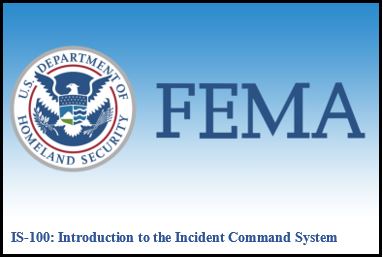
ICS 100, Introduction to the Incident Command System, introduces the Incident Command System (ICS) and provides the foundation for higher level ICS training. This course describes the history, features and principles, and organizational structure of the Incident Command System. It also explains the relationship between ICS and the National Incident Management System (NIMS). The Emergency Management Institute developed its ICS courses collaboratively with:
- National Wildfire Coordinating Group (NWCG)
- U.S. Department of Agriculture
- United States Fire Administration’s National Fire Programs Branch
At the completion of this course, you should be able to:
- Explain the principles and basic structure of the Incident Command System (ICS).
- Describe the NIMS management characteristics that are the foundation of the ICS.
- Describe the ICS functional areas and the roles of the Incident Commander and Command Staff.
- Describe the General Staff roles within ICS.
- Identify how NIMS management characteristics apply to ICS for a variety of roles and discipline areas.

Course Overview
IS200, Basic Incident Command System for Initial Response, reviews the Incident Command System (ICS), provides the context for ICS within initial response, and supports higher level ICS training. This course provides training on, and resources for, personnel who are likely to assume a supervisory position within ICS.
The Emergency Management Institute developed its ICS courses collaboratively with:
- National Wildfire Coordinating Group (NWCG)
- U.S. Department of Agriculture
- United State Fire Administration’s National Fire Programs Branch
Note: IS-200.c is an updated version of the IS-200 course. If you have successfully completed IS-200.b or IS-200.a, you may want to review the new version of the course. For credentialing purposes, the courses are equivalent.
NIMS Compliance
This course is NIMS compliant and meets the NIMS Baseline Training requirements for IS-200.
Course Objectives:
At the completion of this course, you should be able to:
- Explain the principles and basic structure of the Incident Command System (ICS).
- Describe the NIMS management characteristics that are the foundation of the ICS.
- Describe the ICS functional areas and the roles of the Incident Commander and Command Staff.
- Describe the General Staff roles within ICS.
- Identify how NIMS management characteristics apply to ICS for a variety of roles and discipline areas.
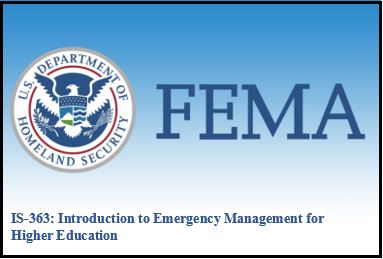
Course Overview
The goal of this course is to provide Institutions of Higher Education (IHEs) with knowledge and planning strategies to protect lives, property, and the environment by supporting operations more effectively within the context of comprehensive emergency management.
Course Objectives:
By the end of this course, you should be able to:
- Define comprehensive emergency management.
- Identify the importance of emergency planning as it relates to the unique needs of an Institution of Higher Education (IHE)
- Identify hazards that present risks for IHEs and the impacts of those hazards
- Identify the process and benefits of conducting a risk assessment
- Identify and create a partnership with internal and external stakeholders
- Define the characteristics of a planning team
- Develop or revise a multi-hazard Emergency Operations Plan (EOP)
- Describe strategies for training and testing the EOP
- Create a Recovery Plan
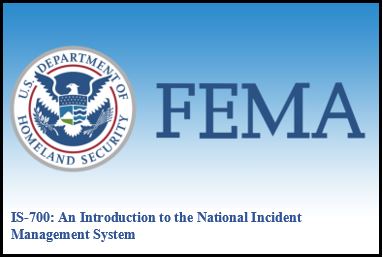
Course Overview
This course provides an overview of the National Incident Management System (NIMS). The National Incident Management System defines the comprehensive approach guiding the whole community – all levels of government, nongovernmental organizations (NGO), and the private sector – to work together seamlessly to prevent, protect against, mitigate, respond to, and recover from the effects of incidents. The course provides learners with a basic understanding of NIMS concepts, principles, and components.
Course Objectives:
At the end of this course, students will be able to:
- Describe and identify the key concepts, principles, scope, and applicability underlying NIMS.
- Describe activities and methods for managing resources.
- Describe the NIMS Management Characteristics.
- Identify and describe Incident Command System (ICS) organizational structures.
- Explain Emergency Operations Center (EOC) functions, common models for staff organization, and activation levels.
- Explain the interconnectivity within the NIMS Management and Coordination structures: ICS, EOC, Joint Information System (JIS), and Multiagency Coordination Groups (MAC Groups).
- Identify and describe the characteristics of communications and information systems, effective communication, incident information, and communication standards and formats.
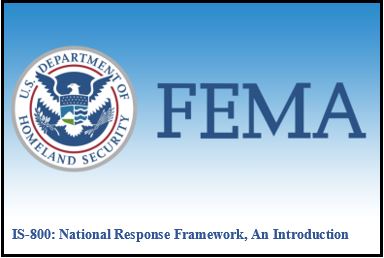
Course Overview
The goal of the IS-0800.d, National Response Framework, An Introduction, is to provide guidance for the whole community. Within this broad audience, the National Response Framework focuses especially on those who are involved in delivering and applying the response core capabilities, including:
- Private sector partners
- Non-governmental organizations (NGOs)
- Government officials
- Community leaders
- Emergency management practitioners
- First responders
Course Objectives:
By the end of this course, students will be able to:
- Describe the purpose, scope, organization, and underlying doctrine of the National Response Framework.
- Describe the roles and responsibilities of response partners.
- Describe core capabilities for response and actions required to deliver those capabilities.
- Describe coordinating structures and operational planning used to support emergency response.
- Describe how the stabilization of the seven Community Lifelines reduces threats to public health and safety, or economic security.
Prerequisites
Recommended: IS-0700, An Introduction to the National Incident Management
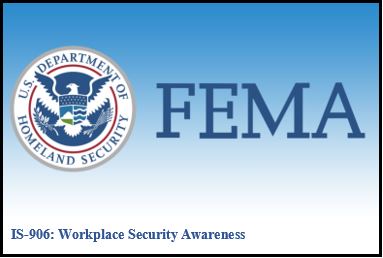
Course Overview
This course provides guidance to individuals and organizations on how to improve the security in your workplace. No workplace—be it an office building, construction site, factory floor, or retail store—is immune from security threats.
Employees are often the target of these threats as well as the organization’s first line of defense against them. Threats endanger the confidentiality, integrity, and security of your workplace, as well as your virtual workplace and computer systems. This course presents information on how employees can contribute to your organization’s security.
Course Objectives:
Upon completing this course, the participant will be able to:
- Identify potential risks to workplace security.
- Describe measures for improving workplace security.
- Determine the actions to take in response to a security situation
For FEMA Account Access:
Log into your FEMA SID Account
Forgot your FEMA SID #
https://cdp.dhs.gov/femasid/account/find
Set-up a new FEMA SID # account
Last Updated June 6, 2024